Free radicals: something to pay attention to (you must read it)
Without realizing, every second we are facing an internal battle in our body. Yes! The battle between antioxidants and free radicals.
Free radicals are atoms or groups of atoms that have an unpaired (e-) electron capable of mating, so they are very reactive. These radicals run through our body trying to steal an electron from stable molecules, in order to achieve their electrochemical stability.
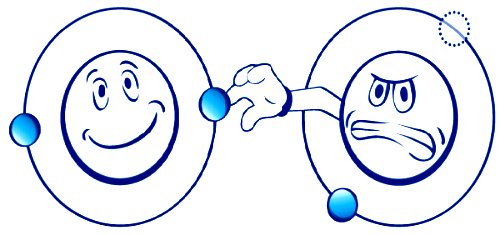
Once the free radical has managed to steal the electron it needs to pair it's free electron, the stable molecule that gives it to it becomes a free radical, because it has an unpaired electron, starting a real chain reaction that destroys our cells (source).
Where do free radicals come from?
Through organic processes our body is able to produce them after food intake, breathing and exercise. Also through environmental exposure, such as pollution, tobacco, radiation, medicines, chemical additives in processed foods and pesticides, to name the most common.
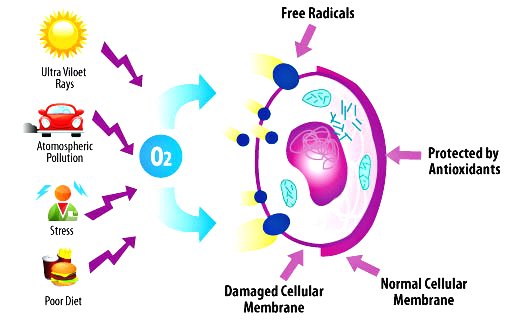
Effects of endogenous and exogenous free radicals (source).
Now, the most important process carried out by free radicals is oxidative stress, this should not be confused with the daily stress derived from the problems that the human body faces in its daily life (work, family, procedures, among others).
In this, reactive oxygen species (ROS, is the term that is applied collectively to radical and non-radical molecules that are oxidizing agents) are easily converted to radicals, under normal conditions there is a balance between the production of free radicals or other reactive species with antioxidant mechanisms (exogenous and endogenous). This balance allows oxidation toxicity to be lower and with less cell damage.
The free radicals produced by the body to carry out certain functions (such as act before the invasion of certain bacteria and viruses), are easily neutralized by our own system. However, when this is not the case, the balance is lost, usually owing to a deficit in the antioxidant system or the uncontrolled proliferation of free radicals, which leads to the free radicals inside the cell attacking DNA (which provides the matrix for cell replication), preventing cell reproduction (source).
Also, when intracellular ROS content exceeds antioxidant defenses of the cell, oxidative stress occurs, causing damage to biological molecules such as lipids, proteins and nucleic acids. Among these, lipid peroxidation is the most relevant, since all cells are surrounded by a lipid bilayer, which functions as a barrier of selective permeability. These are rich in polyunsaturated fatty acids and therefore vulnerable to free radical attack, this, through the action of a hydroxyl radical removes a hydrogen from the side chain of a fatty acid forming a carbon radical, which generates a chain of oxidative reactions (source).
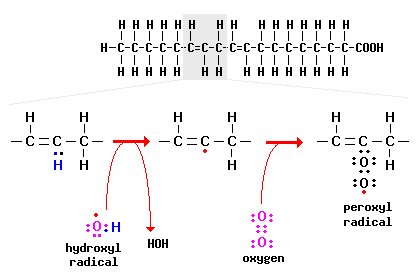
Action of a hydroxyl radical (source).
The presence of free radicals can cause alterations that range from something as mild as the process of aging (by taking the electron they need from the collagen tissue cells of the skin, as a result, the skin loses its elasticity and looks dry and wrinkled) (source).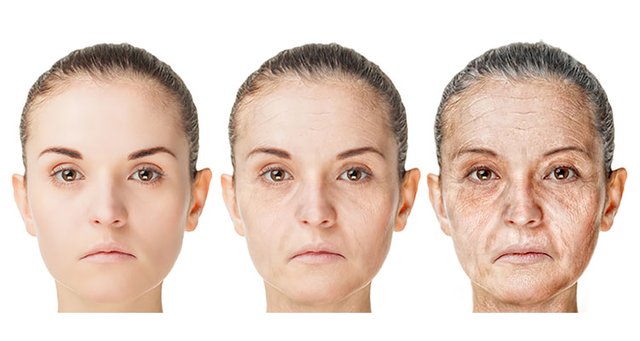
Aging process (source)
To other more serious like degenerative diseases as atherosclerosis, cardiomyopathies, neurological diseases and cancer (where cellular functionality is altered).

Cell degeneration due to free radicals (source).
The inability of our body to neutralize the free radicals (to which we expose ourselves daily) forces us to resort nutrients with the property of neutralizing them. These nutrients act by releasing electrons in our blood that are captured by free radicals, converting them into stable molecules. Compounds with this capability are called antioxidants and recent studies have shown to be the most effective protection against cellular aging and degenerative diseases (source).
Antioxidants are defined as any molecule capable of preventing or delaying the oxidation (loss of one or more electrons) of other molecules, generally biological substrates such as lipids, proteins or nucleic acids.
A: antioxidant. B: free radical (source).
Classification of antioxidants
From a perspective of their origin and presence in the organism, it is possible to classify them between those that are normally bio-synthesized by the organism and those that enter it through the diet.
Among the most important bio-synthesized by the organism, we have:
- Superoxide dismutase (SOD), which catalyzes the dismutation of superoxide into oxygen and hydrogen peroxide, thus protecting the cell from harmful reactions of superoxide. Also, SOD mutations have been related to amyotrophic lateral sclerosis (ALS) as well as its overexpression to Down syndrome.
- Catalase, an enzyme that catalyzes the decomposition of hydrogen peroxide (H2O2) into oxygen and water. It is important to mention that hydrogen peroxide is a residue of the cellular metabolism of many living organisms and has, among others, a protective function against pathogenic microorganisms, mainly anaerobes, but given its toxicity it must quickly transform into less dangerous compounds. Also, the congenital absence of catalase is the cause the Takahara disease, that is manifested by the absence of catalase activity in red blood cells and with severe gangrenous infections of the mouth, which can lead to tooth loss and severe destructions of the jaws and soft regions that covers them.
- Glutathione peroxidase (GPx), which catalyzes the oxidation reaction of glutathione to glutathione disulfide using hydrogen peroxide. The main function of which is to protect the body from the degrading effect of hydroperoxides formed endogenously.
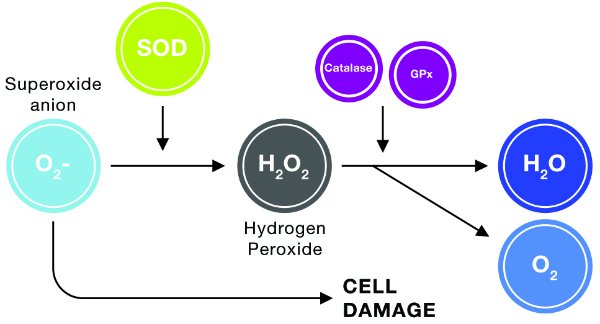
(source)
Regarding the antioxidants that enter the body only through the diet, these are classified, essentially, in:
- Ascorbic acid (vitamin C), is an organic acid (that is not synthesized, so it must be ingested through food) with antioxidant properties from sugar. Its deficiency causes scurvy (see image below) in humans, since it prevents the correct hydroxylation of lysine and proline, therefore defective procollagen chains are obtained and the synthesis can not be finished correctly.
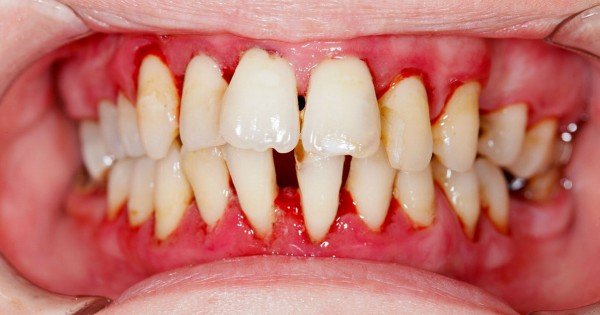
(source)
6 fruits and vitamin C concentration (mg/100g):
 300 |
300 |  90 |
90 | 60 |
60 |  50 |
50 |  40 |
40 |  28
28
- Alpha-tocopherol, its function is to protect polyunsaturated fatty acids from membranes and other cellular structures of lipid peroxidation, which is why it is considered the form of vitamin E that is absorbed and accumulates in the body human. Vitamin E deficiency is associated with neurological symptoms, premature aging, acne, varicose veins, muscle weakness, anemia and degeneration of the retina that can lead to blindness.
6 foods and vitamin E concentration (mg/100g):
 11-149 |
11-149 |  26 |
26 |  26 |
26 |  4 |
4 |  3 |
3 |  1,5
1,5
- Lutein and zeaxanthin are found in the ocular macula lutea, however, these compounds are not transformed into retinol. It is related to the reduction of the degeneration of the ocular macula, having as effect a better vision and prevents the progression of cataracts.
- Flavonoids (definitely my favorites), these ones reduce the risk of cancer, improve allergic and arthritis symptoms, increase the activity of vitamin C, block the progression of cataracts, macular degeneration and They avoid the hot flashes during menopause.
6 foods with flavonoids:






Its effects on humans can be classified as:
- Cardiotonic properties: have a tonic effect on the heart, enhancing the heart muscle and improving circulation. Attributed fundamentally to the flavonoid quercetin although it appears in less intensity in others such as genistein and luteolin. Flavonoids decrease the risk of heart disease.
- Capillary fragility: they improve the resistance of the capillaries and favor that they do not break, so they are adequate to prevent bleeding. The flavonoids with better results in this field are hesperidin, rutin and quercetin.
- Antithrombotic properties: the ability of these components to prevent the formation of thrombi in blood vessels enables better circulation and prevention of many cardiovascular diseases.
- Anti-inflammatories and analgesics: hesperidin, due to its anti-inflammatory and analgesic properties, has been used for the treatment of certain diseases such as arthritis. Tannins have astringent, vasoconstrictive and anti-inflammatory properties, and can be used in the treatment of hemorrhoids.
Thank you for sharing it with us .... It is interesting for everyone